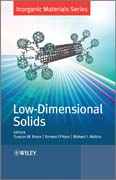
Following the success of Inorganic Materials, the concept of the original book will be updated and extended to reflect the recent expansion of research andapplications in inorganic material chemistry, and its interfaces with physics, biology and materials science. Inorganic materials will be separated into five areas based on their physical properties: porous, functional oxides, molecular, low-dimensional and electronic materials. Each area will be presented in one volume and each chapter will cover recent research areas within the contributors field of knowledge, providing a clear and useable introduction to that field. The chapters of the book will be self-contained and relate to a different area of the volumes general subject matter. This volume is proposed as follows: intercalation in layered materials, boride/carbide/fulleride superconductors, inorganic fullerenes and nanotubes, and oxide nanorods and nanotubes.Professor Duncan Bruce graduated from the University of Liverpool (UK), wherehe also gained his PhD. In 1984, he took up a Temporary Lectureship in Inorganic Chemistry at the University of Sheffield and was awarded a Royal Society Warren Research Fellowship. He was then appointed Lecturer in Chemistry and later Senior Lecturer and co-director of the Sheffield Centre for Molecular Materials. In 1995, he was appointed Professor of Inorganic Chemistry at the University of Exeter. Following the closure of Exeter's chemistry department in 2005, Professor Bruce took up his present position as Professor of Materials Chemistry in York. He is currently Chair of the Royal Society of Chemistry Materials Chemistry Forum. His current research interests include liquid crystals and silicates. His work has been recognized by various awards including the British Liquid Crystal Society's first Young Scientist prize and the RSC's Sir Edward Frankland Fellowship and Corday-Morgan Medal and Prize. He has held visitingpositions in Australia, France, Japan and Italy. Dr. Richard Walton, who was also formerly based in the Department of Chemistry at the University of Exeter, now works in the Department of Chemistry at the University of Warwick. His research group works in the area of solid-state materials chemistry and has a number of projects focusing upon the synthesis, structural characterization andproperties of inorganic materials. Dermot OHare is Professor in the ChemistryResearch Laboratory at the University of Oxford. His research group has a wide range of research interests. They all involve synthetic chemistry ranging from organometallic chemistry to the synthesis of new microporous solids. DuncanBruce and Dermot OHare have edited several editions of Inorganic Materials published by John Wiley & Sons Ltd.
- ISBN: 978-0-470-99751-2
- Editorial: John Wiley & Sons
- Encuadernacion: Cartoné
- Páginas: 320
- Fecha Publicación: 21/05/2010
- Nº Volúmenes: 1
- Idioma: Inglés
